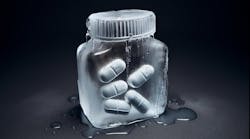Siegfried charts growth strategy, leverages global network of 13 sites in seven countries
With 13 sites across seven countries and more than 500 customers worldwide, contract development and manufacturing organization Siegfried has scaled up its global operations with a focus on the production of drug substances and drug products.
Of Siegfried’s global network of 13 sites, eight locations are optimized for drug substances and five facilities are designed for drug products. Siegfried CEO Marcel Imwinkelried, who took the helm in September 2024, sees the company’s footprint in three continents — Asia, Europe, and North America — as a strategic advantage given the current macroeconomic and geopolitical conditions.
While there’s “nothing you can nowadays predict” in the global economy, Imwinkelried said in October at Siegfried’s Capital Markets Day 2024 that the company is particularly well-positioned to provide to its customers “two supply points — from Europe or the U.S. — which is, by the way, highly appreciated” amid the changing geopolitical dynamics.
Siegfried’s sole Asian site is in Nantong, China, which specializes in the custom synthesis of active pharmaceutical ingredients (APIs) and intermediates for the pharmaceutical industry. The company operates nine sites in Europe including a new quality control lab in Minden, Germany, and a new R&D center for drug substances in Evionnaz, Switzerland.
Siegfried has three U.S. sites: Grafton, Wisconsin, Irvine, California, and Pennsville, New Jersey. Grafton specializes in early-phase development and manufacturing services, including services for projects with highly potent APIs. Irvine is a sterile drug product manufacturing site specializing in innovative and difficult to manufacture pharmaceuticals, ophthalmics, and drug delivery devices, while Pennsville is Siegfried’s drug substance manufacturing site for the U.S. market and provides spray drying operations globally.
In July 2024, Siegfried completed its acquisition of the CDMO in Grafton from Curia Global, expanding Siegfried’s range of drug substances offerings for small and medium-sized pharmaceutical companies.
During a presentation of Siegfried’s full-year 2024 results last month, Imwinkelried made the case that buying the early-phase CDMO site in Grafton strengthened Siegfried’s customer offerings both in terms of geography — namely, expanding its network in the U.S. — and being able to provide full end-to-end services.
Chief Scientific Officer Stefan Randl, who joined Siegfried in January 2025, told Pharma Manufacturing that the CDMO’s end-to-end service offerings from early-stage development through to commercialization — starting with drug substances and moving to drug products — is a value proposition that resonates with customers looking for a one-stop shop for both the development of active ingredients and finished formulated drugs.
Asked about the looming threat of President Donald Trump’s tariffs on pharmaceuticals, Randl said “as long as the details of the policy are not fully known, it’s rather a question of speculation” but for Siegfried the potential U.S. trade policy could also present opportunities.
While the CDMO is by and large based in Europe, Randl noted Siegfried’s “strong U.S. presence” including its recently acquired “Acceleration Hub” in Grafton designed to “help pharmaceutical companies accelerate their early-phase clinical materials.” Siegfried having multiple, reliable supply points — with “manufacturing sites spanning all the way from the U.S., across Europe, to Asia” — is critical for customers in the current geopolitical environment, he said.
Randl added that the company’s EVOLVE+ strategy, launched in October 2024, with a “sharpened” focus on commercial, development and operational excellence are the three pillars on which the CDMO’s is staking its sustained future growth.
Targeting profitable growth
Last month, Siegfried reported fourth quarter and full-year 2024 financial results, with the company touting its continued trajectory of profitable growth which more than offset “substantial” headwinds — including the depreciation of the dollar and euro against the Swiss franc.
Morningstar analyst Rachel Elfman in a note to investors described Siegfried’s year-end results as “solid” and in line with expectations, highlighted by net sales of approximately CHF 1.3 billion, an increase of 3% in local currencies.
Elfman noted the company’s drug substances business accounted for nearly 70% of overall revenue and grew 4.5% from the prior-year period, offsetting the impact of destocking. At the same time, she said that “drug products reported growth in line with the prior year, despite the phasing out of significant vaccine sales in 2024, which demonstrates healthy demand for Siegfried’s outsourced services even with these vaccine challenges.”
Siegfried is well-positioned to capitalize on the longer-term trends of the industry, according to Elfman, who said that the company’s growth over the last 14 years has allowed it to become a leading global CDMO. “Since 2010, sales have quadrupled and the workforce has grown fivefold,” she wrote.
For 2025, Siegfried expects sales growth in the mid-single-digit percentage range in local currencies and a core Earnings Before Interest, Taxes, Depreciation, and Amortization (EBITDA) margin above 22%.
During last month’s presentation of Siegfried’s full-year 2024 results, CFO Reto Suter said going forward the company is set to outpace market growth across its key segments, while confirming its positive mid-term outlook for continued profitable growth above market — excluding mergers and acquisitions (M&A).
“We continue to make the vast majority of what we do in revenues from commercial manufacturing — between 90% and 95% — and the remainder 5% to 10% we do in the clinical phases,” according to Suter. He said that the completion of Siegfried’s Grafton acquisition last year “serves the purpose to accelerate the inflow of additional valuable molecules into our high-quality manufacturing network.”
M&A “has been important in the past, it’s important now, and it’s also going to be important in the future” for Siegfried, Suter emphasized, providing scale, capabilities, and technologies to the company’s service offerings.






